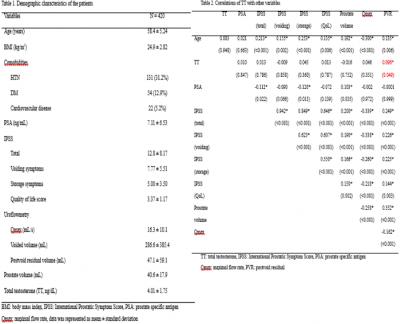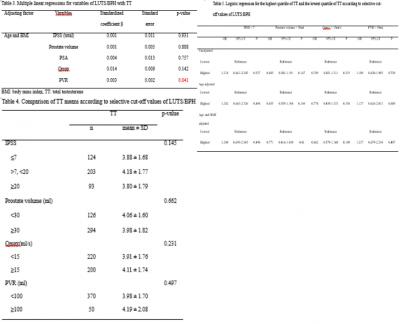|
|
|
중년 남성에게서 전립선 비대증, 하부요로증상과 혈중 테스토스테론 수치와의 연관성이 있는가? |
| 전남대학교 의과대학 비뇨의학과교실 |
| 구진석, 조현진, 송재익, 이호연, 김재현, 임도경, 김태희, 은성종, 오주용, 유성현, 김명수, 정호석, 황의창, 오경진, 김선옥, 정승일, 강택원, 권동득, 박광성 |
INTRODUCTION:
To investigate the relationship between lower urinary tract symptoms (LUTS)/benign prostatic hyperplasia (BPH) and total serum testosterone level (TT) in middle-aged men.
METHODS:
This Study was conducted in men under 65 years of age who visited our hospital due to lower urinary tract symptoms from Jan, 2015 to Dec, 2019. Patients with comorbidities affecting voiding function or incomplete data were excluded. LUTS/BPH were assessed by prostate-related parameters, international prostate symptom score (IPSS) and uroflowmetric parameters. We evaluated the relationship between TT and LUTS/BPH variables.
RESULTS:
A total of 420 patients were eligible for final analysis. The median age and TT level were 58.4 years and 4.01 ng/mL, respectively. The TT level showed positive correlations with PVR (r = 0.096, P = 0.049), but not clinically significant. After adjusting for age and BMI, PSA, Qmax, TPV and total IPSS did not significantly correlate with TT, whereas PVR was correlated (p=0.041). On comparison of TT means according to selective cut-off values of LUTS/BPH, there was no difference in the value of TT. Logistic regression revealed that no significant difference was found in surrogate measures of LUTS/BPH (TPV > 30 mL, IPSS > 7, Qmax < 15 mL/second, and PVR > 50 mL) between the highest quartile TT group (median: 5.96 ng/mL) and the lowest quartile group (median: 2.41 ng/mL).
CONCLUSION:
In our study, TT may have a slightly impact on PVR, but there was no clear correlation with LUTS/BPH in middle-aged men. |
  |
|
keywords : Total serum testosterone level, Benign prostatic hyperplasia, Lower urinary tract symptom |
|

